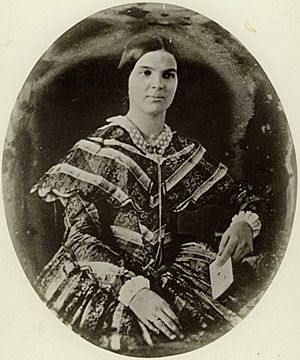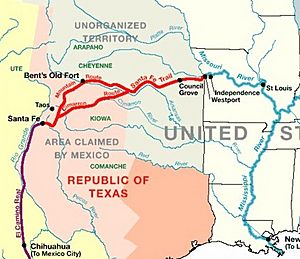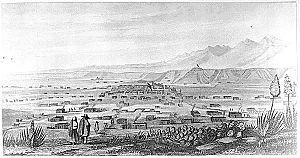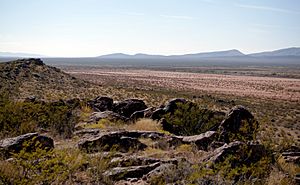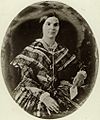Susan Shelby Magoffin facts for kids
Susan Shelby Magoffin (born July 30, 1827 – died October 26, 1855) was an American woman who traveled the Santa Fe Trail in the 1840s. She was married to a trader from the United States. Susan kept a detailed diary of her journey. This diary has become a very important source for historians. It helps them understand what life was like during that time.
Contents
Susan's Early Life and Family
Susan Shelby was born on July 30, 1827. Her family was very rich and lived on a large farm near Danville, Kentucky. Her grandfather was Isaac Shelby. He was a hero in the American Revolutionary War. He also became the first governor of Kentucky.
On November 25, 1845, when Susan was eighteen, she married Samuel Magoffin. Samuel's father was an immigrant from Ireland who became very successful in Kentucky. Samuel and his brother, James Wiley Magoffin, were involved in the Santa Fe trade since the 1820s. This trade involved moving goods between the United States and Mexico. They traveled a lot and became very wealthy.
Traveling the Santa Fe Trail
In 1846, Samuel Magoffin decided to take his new wife, Susan, on his next trading trip. They left Independence, Missouri, on June 10, 1846. They tried to make the journey as comfortable as possible. Their group included many large wagons pulled by oxen. They also had a special carriage for Susan and a smaller wagon for her maid. They even brought a cook and live chickens! Susan believed she was the first "American lady" to make this long trip.
Challenges on the Journey
The journey was very difficult. On July 31, 1846, just after her nineteenth birthday, Susan became very ill at Bent's Fort. The Magoffins finally reached Santa Fe, New Mexico, on August 31, 1846. From there, they continued south into Mexico. They traveled to places like El Paso del Norte, Chihuahua, and Saltillo.
Susan's health got worse because of the hard travel. While she was sick in Matamoros, Chihuahua, she gave birth to a son who sadly did not survive.
Return to Kentucky and Later Life
The Magoffins returned to Kentucky in 1848. A daughter was born to them in 1851. In 1852, they moved to a large estate near Kirkwood, Missouri. Susan's health had been permanently affected by the tough journey on the Santa Fe Trail. A second daughter was born in 1855. Susan died soon after, on October 26, 1855. She was buried in St. Louis, Missouri.
Susan's Changing Views
At first, Susan Magoffin had common ideas about Native Americans and Mexicans. She thought they were not as advanced as people from her own culture. However, as she met and got to know them, her opinions quickly changed.
For example, she was amazed when a Native American woman gave birth and then went to the river to bathe herself and her baby soon after. Susan wrote that this "heathenish custom" might actually be better than the way women were treated during childbirth in her own society.
She also wrote about Mexicans, saying, "I did think the Mexicans were as void of refinement, judgement etc. as the dumb animals till I heard one of them say 'bonita muchachita' [pretty little girl]! And now I have reason and certainly a good one for changing my opinion; they are certainly a very quick and intelligent people." When she reached El Paso del Norte, she was very impressed by how polite and educated her Mexican hosts were.
Susan's Important Journal
Susan Magoffin's journal tells the story of her journey from the beginning until September 8, 1847. The Magoffins traveled the Santa Fe Trail and went into Mexico. This happened right after the United States army invaded during the Mexican–American War (1846–1848). Her journal is a very valuable source of information. It describes the conditions of the time, the people she met, and the events that happened. It is especially unique because it offers a woman's view of these historical events.
Across the Plains
The journey took the Magoffins west from Independence, Missouri. They crossed the wide grasslands of what is now Kansas. Susan saw many migrating buffaloes there. She wrote about how delicious the buffalo meat was, even better than food from fancy hotels.
However, after a while, the excitement of seeing buffalo wore off. She wrote that they saw thousands of buffalo, but they looked "ugly, ill-shapen things." She also saw a burial on the plains. She was impressed by how much effort people took to protect the body from wolves. They dug a deep grave and covered it with stones.
The journey was full of challenges. On July 4, their carriage rolled over. On July 21, their tent fell down during a strong storm.
At Bent's Fort and Santa Fe
Susan became sick. When they arrived at Bent's Fort on July 27, she had to stay in bed in the private rooms they had booked. The "Army of the West" was also at the fort. This army was getting ready to invade New Mexico to the south.
Soon after her nineteenth birthday, Susan suffered a personal loss, which made them delay their trip. They left Bent's Fort on August 14, 1846. They reached a Mexican settlement called Mora creek on August 25. Susan was surprised by the simple houses there. The next day, they arrived at Las Vegas, New Mexico. They continued south to Santa Fe, reaching it on August 31.
The U.S. army, led by General Stephen W. Kearny, had entered Santa Fe on August 15, 1846. They faced no resistance because the Mexican governor, Manuel Armijo, told his soldiers not to fight. Susan's brother-in-law, James Magoffin, had talked with Governor Armijo.
In Santa Fe, the Magoffins became part of the important social scene. They met wealthy traders, army officers, and important Hispanic families. Susan described Doña Gertrudes Barcelo as a powerful woman who ran a popular gambling house.
Today, if you visit Bent's Fort, you can see "Susan's Room." It is a recreated room on the upper level, showing how it might have looked when Susan stayed there.
Journeying South into Mexico
The Magoffins continued their journey south on October 7, 1846. They followed El Camino Real de Tierra Adentro. This was the main route south. Along the way, they met Pueblo Indians, who were the main farming people of New Mexico. Susan noticed that the Pueblo people would pay twice as much for empty glass bottles as the bottles cost when full in the United States.
They stayed for a while at San Gabriel. Susan became sick with a fever there. A local lady taught her how to make tortillas. Susan found it was much harder work than she expected! The lady also showed her different knitting techniques.
They left San Gabriel in late January 1847. They traveled south through a desert area called the Jornada del Muerto to Doña Ana. There was a local uprising called the Taos rebellion happening. This meant they were worried about attacks from Mexicans, in addition to the dangers of crossing the desert.
On February 17, 1847, they arrived at El Paso del Norte. They stayed at the large house of a priest named Ramón Ortiz y Miera. His house was surrounded by fruit trees and vineyards. Father Ortiz was a strong supporter of Mexico. He had been taken prisoner by Colonel Alexander William Doniphan for encouraging people to fight the U.S. army. However, he was also known for being very welcoming to visitors.
Susan was very impressed by the polite atmosphere of the house. She was especially taken with a little girl. She wrote that the six-year-old girl acted with the dignity of an eighteen-year-old. The girl entered the room, bowed politely, said "Bonus tardes" (Good afternoon), shook Susan's hand, and sat down.
The Magoffins continued south, following Colonel Doniphan's army. Susan's health kept getting worse because of the difficult travel. Her journal ends on September 8, 1847.
Television Show
In 1965, an actress named Linda Marsh played Susan Shelby Magoffin in a TV show. It was an episode called "No Place for a Lady" from the series Death Valley Days. Simon Scott played Susan's husband, Samuel. The show's host, Ronald W. Reagan, played a frontiersman named William Bent.
Images for kids


